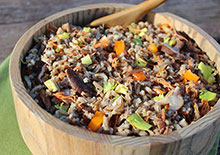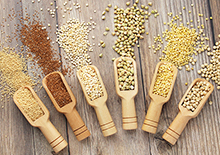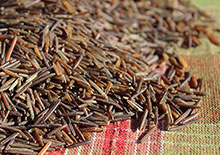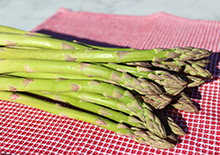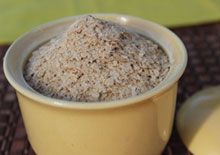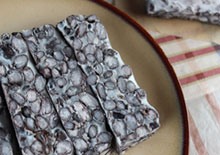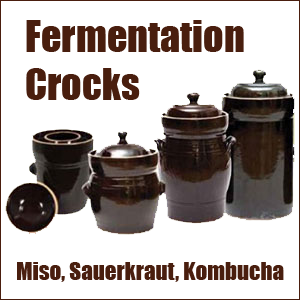- Home
- Plant-Based Cooking
- Tempeh Recipes
Ways to Prepare Tempeh in Recipes

Tempeh recipes can be made in much the same way you would prepare meat or tofu. The texture is firm yet flexible and is delicious when lightly seasoned as well as braised with sauces.
Tempeh, being a type of "bean cake" created by culturing cooked beans with the Rhizopus oligosporus spore culture, is a highly versatile food.
Over the short lacto-fermentation process, the beans are literally woven together with a savory edible white mycelium, producing a sliceable and meaty consistency.
Straight cooked beans are notorious for causing gastrointestinal upset and flatulence if not properly prepared. Consuming tempeh is one of the best ways to eat legumes as many of these common side-effects are eliminated.
Some varieties, depending on the specific source of spore cultures used, are also found to contain vitamin B12.
In one study it was shown that two other beneficial airborne bacteriums, Citrobacter freundii and Klebsiella pneumoniae, are naturally inoculated during the fermentation process and are responsible for increased amounts of B12. The study concluded that "This result supports the suggested use of these two strains to form vitamin B12 during tempeh fermentation in Indonesia."
Uncooked Vs. Cooked Tempeh
Uncooked or Low-Temp Cooked
Being a fermented food, it does contain enzymes and microflora that will be destroyed when high temperature heated over 118°F (48°C). While some people might enjoy tempeh unheated as way to preserve some of these nutrients, we find it less palatable as a cold food.
Remember, there is no such thing as "raw" tempeh, as all bean cake is initially cultured using cooked beans.
Dehydrating or lightly steaming tempeh will ensure higher amounts of beneficial microflora and enzyme content. This objective can also be achieved by adding it, cubed or crumbled, on top of cooked meals or into low-temp soups and stews.
Cooked Tempeh
In our opinion, the best types of tempeh recipes use some
kind of cooking process. It is just simply more flavorful to eat from
our experience.
One of the best parts about tempeh, whether cooked or uncooked, is that the fermentation process
essentially pre-digests the protein content, making it more digestible as an
amino acid-rich vegan protein source.
Top Ways to Use Tempeh
- Sandwich Ingredient
- In a Stir Fry Medley
- A Top a Salad
- As a Tempeh Burger
- On a Skewered Shish Kabob
- As Tempeh Bacon
- Crumbled as a Sloppy Joe
- Baked with Vegetables

Tempeh Making Tips
Freezing Tempeh for Later Use
Tempeh is a food that can be frozen and still retain its form and nutritional value. Whether you purchase it from the store or make your own homemade version, large quantities can be sliced, marinated and frozen for later use.
For those on a busy schedule, your tempeh is ready and waiting whenever you want a quick meal that doesn't take a lot of prep time, just some slight thawing is required.
Shaping Homemade Tempeh
When making homemade tempeh you are not limited to simple square blocks but can really create any shape you like. This is because tempeh, when cultured, produces a soft flexible bean cake that can be cut using a cookie cutter to make a variety desired shapes and sizes.This is the best way to make tempeh burgers.
Freshly fermented tempeh can also be formed by hand and rolled into "meatballs".
How to Prepare Tempeh
1) Baked Tempeh
Tempeh is very enjoyable as a baked dish, simply cubed or sliced and placed in the oven for a relatively short amount of time. With a little coconut oil it will produce a crisp and golden brown texture.
Baking tempeh is an excellent option which doesn't necessary require the use of oils if you're not into using them.
Directions:
- Preheat oven to 350° F (175° C).
- Slice or cube tempeh, but remember the thicker the pieces the longer it will take.
- Toss in a bowl with culinary spices of choice, melted coconut oil and a little tamari, shoyu or soy sauce.
- Place in a glass or ceramic baking dish.
- Bake for 30-40 minutes, flipping mid-way through cooking time.

2) Marinated Tempeh
Although store-bought tempeh can taste somewhat bland on its own, like tofu or meat, homemade tempeh is quite different and in our opinion doesn't require much spice because it is so darn flavorful and rich tasting. Either variety, however, can also be marinated in any kind of sauce to create variety.
Typically we like to make a marinade dressing using a sweetener, an acid and a salt. This may include lemon juice or vinegar, pink salt or tamari, honey or maple syrup, liquid oil and a spice mix like italian herbs. Thicker sauces, like a sweet and sour sauce, can also be used and applied using a culinary brush.
Directions:
- Prepare a marinade sauce.
- After you have made your sauce, cut your tempeh into long strips about 1/4 of an inch thick.
- On a flat plate line up your tempeh strips and pour or brush on the mixed ingredients.
- Allow to marinate for at least one hour.
- Grill, bake or dehydrate.
3) Steamed Tempeh
This is probably the easiest way to make tempeh and doesn't require the use of oils or cooking fats. Slightly steaming the tempeh on low heat will keep some of the enzymes and beneficial lactic acid bacteria from being completely destroyed.
This method makes it softer, less firm but still enjoyable to eat. Other seasonings can be added after this cooking process.
Directions:
- Add pure water to a glass or ceramic pot.
- Place a steamer basket with cubed tempeh pieces (and any vegetables) into the pot.
- Bring to a boil with the lid on.
- Turn to low heat and allow to steam in simmering water.
- Remove tempeh after 5-10 minutes, depending on what you prefer.

4) Grilled or Barbecued Tempeh
Whether grilled via pan-frying or shish kabobed on a barbecue, tempeh prepared in this fashion is a taste enhancing way to experience this fermented bean cake. It's a great alternative for those wanting to replace meat proteins.
This is the best way to produce a desired crispiness that many people enjoy. It does require a bit of cooking oil however and for that we recommend our two favorite medium heat stable tropical oils, coconut oil and red palm oil.
Directions:
- Slice into triangles, use whole tempeh burgers or cube onto skewer sticks with assorted vegetables.
- Brush on a slight amount of cooking oil onto tempeh and place on a grill or barbecue.
- Grill to preferred crispy texture.
- If desired, add barbecue sauce with a culinary brush, close to end of this process.
5) Sautéed or Stir-Fried Tempeh
Sautéed into a stir-fry dish, tempeh with vegetables is a delicious way to eat this fermented food. It also provides a very pleasant meal when served as a straight sauté with onions, garlic and leafy green vegetables, like kale.
Directions:
- Cube the tempeh into bite size pieces.
- Heat a pan or wok on medium-high heat.
- Add a coconut oil or red palm oil.
- Add assorted chopped vegetables and tempeh.
- Stir consistently for 10-15 minutes until vegetables are partially cooked.
- Remove from heat, add a homemade stir-fry sauce and serve with a grain such as quinoa or millet.
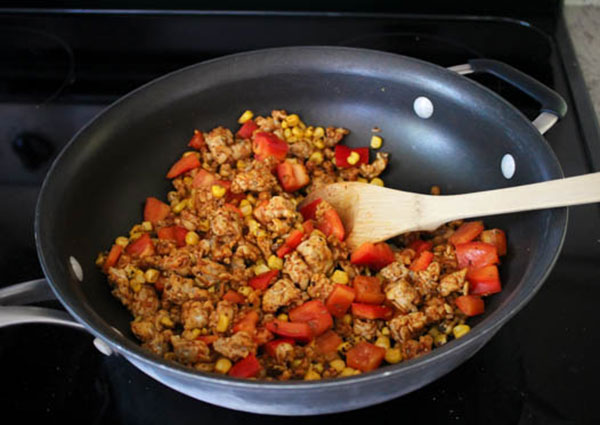
6) Crumbled Tempeh
This is a great way to use tempeh at the last minute to increase the protein content of a meal. Crumbled into sauces and stews or used to make tempeh tacos, sloppy joes, chili, curry or spaghetti sauce, it can be incorporated in much the same way as ground beef. Like tofu, tempeh takes on the flavor of whatever spices, sauces or foods it is prepared with, but will also add a rich mushroom-like flavor.
Directions:
- Take fresh tempeh and crumble it with your clean hands or in a food processor.
- Add it directly to sauces or other entrées.
- Or, sauté it like ground beef using coconut oil.
7) Dehydrated Tempeh
This is a great way to prepare tempeh if you're not into baking, grilling or stove-top cooking it and this method will preserve the enzymes and some of the lactic acid bacteria present in the bean cake. We like to make dehydrated tempeh in two different ways.
One is to marinate thinly sliced tempeh and dehydrate it on teflex sheets at a medium to high temperature for several hours. This will produce slightly heated slices that are somewhat crispy on the outside.
The other way is to slice and completely dehydrate it on a low to medium heat setting until it produces a crunchy snack-like chip.
Directions:
- Slice your tempeh into strips.
- Apply a marinade and allow to sit for 1 hour.
- Place on a dehydrator screen with a teflex sheet on top.
- Dehydrate for 3 hours on high heat setting for a warmed slightly crisp tempeh or leave in the dehydrator on medium-heat for 12-24 hours, depending on thickness.
Learn how to make homemade black bean or black-eyed pea tempeh recipes or visit our fermented food recipes page for more ideas on how to culture your own foods and drinks.
(Also, visit our healthy cooking tips page for ways to make cooked foods more nutritious.)
